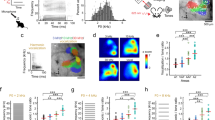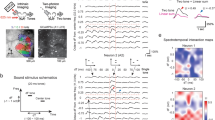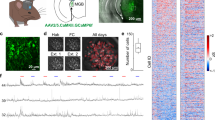Abstract
The spatial arrangement of inputs on to single neurons is assumed to be crucial in accurate signal processing. In mammals, the most precise temporal processing occurs in the context of sound localization. Medial superior olivary neurons can encode microsecond differences in the arrival time of low-frequency sounds at the two ears. Here we show that in mammals with well developed low-frequency hearing, a spatial refinement of ionotropic inhibitory inputs occurs on medial superior olivary neurons during development. This refinement is experience dependent and does not develop in mammals that do not use interaural time differences for sound localization.
This is a preview of subscription content, access via your institution
Access options
Subscribe to this journal
Receive 12 print issues and online access
$209.00 per year
only $17.42 per issue
Buy this article
- Purchase on Springer Link
- Instant access to full article PDF
Prices may be subject to local taxes which are calculated during checkout






Similar content being viewed by others
References
Häusser, M., Spruston, N. & Stuart, G. J. Diversity and dynamics of dendritic signaling. Science 290, 739–744 (2000).
Craig, A. M., Blackstone, C. D., Huganir, R. L. & Banker, G. The distribution of glutamate receptors in cultured rat hippocampal neurons: postsynaptic clustering of AMPA-selective subunits. Neuron 10, 1055–1068 (1993).
Lin, B., Martin, P. R., Solomon, S. G. & Grunert, U. Distribution of glycine receptor subunits on primate retinal ganglion cells: a quantitative analysis. Eur. J. Neurosci. 12, 4155–4170 (2000).
Nyiri, G., Freund, T. F. & Somogyi, P. Input-dependent synaptic targeting of α2-subunit-containing GABAA receptors in synapses of hippocampal pyramidal cells of the rat. Eur. J. Neurosci. 13, 428–442 (2001).
Erulkar, S. D. Comparative aspects of sound localization. Physiol. Rev. 52, 237–360 (1972).
Goldberg, J. M. & Brown, P. B. Response of binaural neurons of dog superior olivary complex to dichotic tonal stimuli: some physiological mechanisms of sound localization. J. Neurophysiol. 32, 613–636 (1969).
Yin, T. C. & Chan, J. C. Interaural time sensitivity in medial superior olive of cat. J. Neurophysiol. 64, 465–488 (1990).
Grothe, B. The evolution of temporal processing in the medial superior olive, an auditory brainstem structure. Prog. Neurobiol. 61, 581–610 (2000).
Inbody, S. B. & Feng, A. S. Binaural response characteristics of single neurons in the medial superior olivary nucleus of the albino rat. Brain Res. 210, 361–366 (1981).
Grothe, B. & Park, T. J. Sensitivity to interaural time differences in the medial superior olive of a small mammal, the Mexican free-tailed bat. J. Neurosci. 18, 6608–6622 (1998).
Joris, P. X., Smith, P. H. & Yin, T. C. Coincidence detection in the auditory system: 50 years after Jeffress. Neuron 21, 1235–1238 (1998).
Cant, N. B. & Hyson, R. L. Projections from the lateral nucleus of the trapezoid body to the medial superior olivary nucleus in the gerbil. Hear. Res. 58, 26–34 (1992).
Grothe, B. & Sanes, D. H. Synaptic inhibition influences the temporal coding properties of medial superior olivary neurons: an in vitro study. J. Neurosci. 14, 1701–1709 (1994).
Agmon-Snir, H., Carr, C. E. & Rinzel, J. The role of dendrites in auditory coincidence detection. Nature 393, 268–272 (1998).
Simon, J. Z., Carr, C. E. & Shamma, S. A. A dendritic model of coincidence detection in the avian brainstem. Neurocomputing 26–27, 263–269 (1999).
Spitzer, M. W. & Semple, M. N. Neurons sensitive to interaural phase disparity in gerbil superior olive: diverse monaural and temporal response properties. J. Neurophysiol. 73, 1668–1690 (1995).
Smith, P. H., Joris, P. X. & Yin, T. C. Projections of physiologically characterized spherical bushy cell axons from the cochlear nucleus of the cat: evidence for delay lines to the medial superior olive. J. Comp. Neurol. 331, 245–260 (1993).
Russell, F. A. & Moore, D. R. Afferent reorganisation within the superior olivary complex of the gerbil: development and induction by neonatal, unilateral cochlear removal. J. Comp. Neurol. 35, 607–625 (1995).
Smith, P. H., Joris, P. X. & Yin, T. C. Anatomy and physiology of principal cells of the medial nucleus of the trapezoid body (MNTB) of the cat. J. Neurophysiol. 79, 3127–3142 (1998).
Taschenberger, H. & von Gersdorff, H. Fine-tuning an auditory synapse for speed and fidelity: developmental changes in presynaptic waveform, EPSC kinetics, and synaptic plasticity. J. Neurosci. 20, 9162–9173 (2000).
Heffner, R. S. & Heffner, H. E. Sound localization and use of binaural cues by the gerbil (Meriones unguiculatus). Behav. Neurosci. 102, 422–428 (1988).
Kneussel, O. M. & Betz, H. Receptors, gephyrin and gephyrin-associated proteins: novel insights into the assembly of inhibitory postsynaptic membrane specializations. J. Physiol. 525, 1–9 (2000).
Sanes, D. H. The development of synaptic function and integration in the central auditory system. J. Neurosci. 13, 2627–2637 (1993).
Kandler, K. & Friauf, F. Development of glycinergic and glutamatergic synaptic transmission in the auditory brainstem of perinatal rats. J. Neurosci. 15, 6890–6904 (1995).
Sanes, D. H., Markowitz, S., Bernstein, J. & Wardlow, J. The influence of inhibitory afferents on the development of postsynaptic dendritic arbors. J. Comp. Neurol. 321, 637–344 (1992).
Withington-Wray, D. J., Binns, K. E., Dhanjal, S. S., Brickley, S. G. & Keating, M. J. The maturation of the superior collicular map of auditory space in the guinea pig is disrupted by developmental auditory deprivation. Eur. J. Neurosci. 2, 693–703 (1990).
Vater, M. Ultrastructural and immunocytochemical observations on the superior olivary complex of the mustached bat. J. Comp. Neurol. 358, 155–180 (1995).
Clark, G. M. The ultrastructure of nerve endings in the medial superior olive of the cat. Brain Res. 14, 293–305 (1969).
Perkins, R. E. An electron microscopic study of synaptic organization in the medial superior olive of normal and experimental chinchillas. J. Comp. Neurol. 148, 387–415 (1973).
Langford, T. L. Responses elicited from medial superior olivary neurons by stimuli associated with binaural masking and unmasking. Hear. Res. 15, 39–50 (1984).
Pouille, F. & Scanziani, M. Enforcement of temporal fidelity in pyramidal cells by somatic feed-forward inhibition. Science 293, 1159–1163 (2001).
Suneja, S. K., Benson, C. G. & Potashner, S. J. Glycine receptors in adult guinea pig brain stem auditory nuclei: regulation after unilateral cochlear ablation. Exp. Neurol. 154, 473–488 (1998).
Lichtman, J. W. & Colman, H. Synapse elimination and indelible memory. Neuron 25, 269–278 (2000).
Keller-Peck, C. R. et al. Asynchronous synapse elimination in neonatal motor units: studies using GFP transgenic mice. Neuron 31, 381–394 (2001).
Katz, L. C. & Shatz, C. J. Synaptic activity and the construction of cortical circuits. Science 274, 1133–1138 (1996).
Chapman, B., Jacobson, M. D., Reiter, H. O. & Stryker, M. P. Ocular dominance shift in kitten visual cortex caused by imbalance in retinal electrical activity. Nature 324, 154–156 (1986).
Kakizawa, S., Yamasaki, M., Watanabe, M. & Kano, M. Critical period for activity-dependent synapse elimination in developing cerebellum. J. Neurosci. 20, 4954–4961 (2000).
Ichise, T. et al. mGluR1 in cerebellar Purkinje cells essential for long-term depression, synapse elimination, and motor coordination. Science 288, 832–1835 (2000).
O'Leary, D. D., Ruff, N. L. & Dyck, R. H. Development, critical period plasticity, and adult reorganizations of mammalian somatosensory systems. Curr. Opin. Neurobiol. 4, 535–544 (1994).
Sanes, D. H. & Takacs, C. Activity-dependent refinement of inhibitory connections. Eur. J. Neurosci. 5, 570–574 (1993).
Rietzel, H. J. & Friauf, E. Neuron types in the rat lateral superior olive and developmental changes in the complexity of their dendritic arbors. J. Comp. Neurol. 390, 20–40 (1998).
Sanes, D. H. & Rubel, E. W. The ontogeny of inhibition and excitation in the gerbil lateral superior olive. J. Neurosci. 8, 682–700 (1988).
Craig, A. M., Blackstone, C. D., Huganir, R. L. & Banker, G. Selective clustering of glutamate and γ-aminobutyric acid receptors opposite terminals releasing the corresponding neurotransmitters. Proc. Natl. Acad. Sci. USA 91, 12373–12377 (1994).
Komatsu, Y. GABAB receptors, monoamine receptors, and postsynaptic inositol trisphosphate–induced Ca2+ release are involved in the induction of long-term potentiation at visual cortical inhibitory synapses. J. Neurosci. 16, 6342–6352 (1996).
Alvarez, F. J., Dewey, D. E., Harrington, D. A. & Fyffe, R. E. Cell-type specific organization of glycine receptor clusters in the mammalian spinal cord. J. Comp. Neurol. 379, 150–170 (1997).
Bi, G. Q. & Poo, M. M. Synaptic modifications in cultured hippocampal neurons: dependence on spike timing, synaptic strength, and postsynaptic cell type. J. Neurosci. 18, 10464–10472 (1998).
Feldman, D. E. Timing-based LTP and LTD at vertical inputs to layer II/III pyramidal cells in rat barrel cortex. Neuron 27, 45–56 (2000).
Kotak, V. C. & Sanes, D. H. Long-lasting inhibitory synaptic depression is age- and calcium-dependent. J. Neurosci. 20, 5820–5826 (2000).
Acknowledgements
We thank U. Koch and O. Gleich for technical advice; C. Schulte, G. Breutel and D. Büringer for technical help; and M. Götz, T. Bonhoeffer, M. Hübener, A. Kossel, G. Neuweiler, T. Park and H. Thoenen for critical comments on the manuscript. Supported by Max-Planck-Gesellschaft and Deutsche Forschungsgemeinschaft (GR1205/10-1).
Author information
Authors and Affiliations
Corresponding author
Rights and permissions
About this article
Cite this article
Kapfer, C., Seidl, A., Schweizer, H. et al. Experience-dependent refinement of inhibitory inputs to auditory coincidence-detector neurons. Nat Neurosci 5, 247–253 (2002). https://doi.org/10.1038/nn810
Received:
Accepted:
Published:
Issue Date:
DOI: https://doi.org/10.1038/nn810
This article is cited by
-
Neuronal morphology and synaptic input patterns of neurons in the intermediate nucleus of the lateral lemniscus of gerbils
Scientific Reports (2023)
-
Leveling up: a long-range olivary projection to the medial geniculate without collaterals to the central nucleus of the inferior colliculus in rats
Experimental Brain Research (2022)
-
Assembly and maintenance of GABAergic and Glycinergic circuits in the mammalian nervous system
Neural Development (2018)
-
Activity-dependent formation of a vesicular inhibitory amino acid transporter gradient in the superior olivary complex of NMRI mice
BMC Neuroscience (2017)
-
Sound localization with microsecond precision in mammals: what is it we do not understand?
e-Neuroforum (2015)



